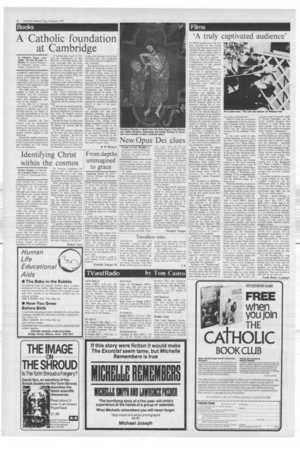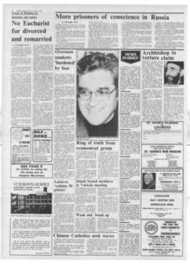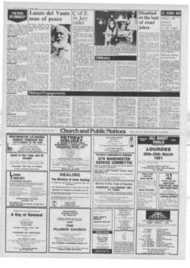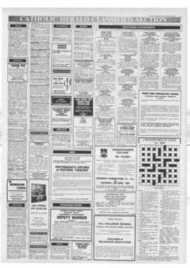Page 6, 6th February 1981
Page 6

Report an error
Noticed an error on this page?If you've noticed an error in this article please click here to report it.
Tags
Share
Related articles
Loneliness Can Be One Of The Great Dangers
A Chance For The Church To Follow The Un On Disabled
Widening Aisles And Minds
Campaign Highlights Help For Disabled
Trappings Of A Royal Patron
'A truly captivated audience'
AS MOST people know 1981 has been declared by the United Nations the International Year of Disabled People. Apart from the unwieldy title or initials, there is always a risk that such years — or days — may prove counter productive. But the IYDP's aims of integration into society and of enlightenment of the general attitude are impeccable.
The National Film Theatre has been alert to respond with a special season (from February 2 to 21) and boldly called it Carry On Cripple. "If our title offends your sensibilities", says a programme note, "Then you need this season".
The 22 movies have been chosen by two men with disabilities, one epileptic, one post-polio. All are films of some distinction in their own right, opening with The Men (Feb. 2) Marlon Brando's debut in Zinnemann's moving film of warwounded paraplegics; and including The Best Years of Our Lives (Feb. 4) with Harold Russell, a real-life amputee, as the handless sailor. The point of the season is that the movies are not chosen to illustrate the promoters' policies except in reverse, to show up what they call the "stereotypes ' of disablement as usually shown — as freaks or monsters to be treated with indifference or ignorance, patronised or sentimentalised. To make sense of the season therefore, you really need to read some of the comments in the programme booklet.
Steve Dwoskim and Allan Sutherland admit as a weakness that all the movies but one are made by able-bodied people about the disabled: films like the Spanish black comedy, The Wheelchair, Alan Arkin's fine performance as the deaf-mute in Carson McCullers's The Heart is A Lonely Hunter (Feb. 6); Moulin Rouge about ToulouseLautrec or Sunrise at Campobello about President Roosevelt.
The exception is Behindert, Dwoskin's own film about the relationship between a disabled man and an able-bodied woman made for West Germany where it won the 1975 award for the Best Film Production.
One film of special interest which exemplifies the season's sane approach to its difficult theme is the Japanese Life and Opinion of Masseur lchi. This is a traditional Japanese tale of the blind swordsman, a noble hero who hides his Samurai sword in a. blind man's walking stick. Another exceptional movie should be Let There Be Light (Feb. 19), John Huston's 1946 documentary for the American war office about the rehabilitation of neurophyshiatric war casulaties.
Nearly 20 years ago, I thought my booklet London for the Disabled would revolutionise the entertainment world, so shocked would people be to learn that theatres and cinemas were barred to wheelchairs. Since then things are slightly better in a few respects, in others even worse, as with the "twinned" cinemas with all their stairs and the insuperable fire regulations.
Perhaps a real "breakthrough" could only be made by recognising that most disabled people would far rather take the minimal risk of being last out of a fire or other disaster than never get to any public entertainment.
The NET itself has always been as enlightened as the law permits about disabled clients. providing both for booking and comforts. NFT1 has the best-equipped lavatory for the disabled I have seen.
In the outer world of ablebodied filmgoing, so far this year, the film I have enjoyed most is Hopscotch ("AA", Plaza, Odeon, Kensington) which I also consider the most under-rated comedy for a year or two. It has a witty script by Bryan Forbes and Brian Gardield from the latter's novel sending up Secret Services.
Walter Matthau and Glenda Jackson at her most charming make a strong team as a pair of experienced agents conducting a middle-aged long-distance love affair based on Washington and Salzburg. It has an appropriately civilised score (mostly Mozart) and the direction keeps up a smart pace.
When the Matthau character is fired by a smug senior colleague, he turns the tables on the whole department and the action into a lively chase where the chief spy becomes the quarry. Great fun.
Most distinguished of the new films is Louis Matte's Atlantic -City ("AA", Curzon). As the title suggests. the film is more frankly American than French, in spirit as well as setting. But Malle's elegance and style drew from the story of dope-pushers and general derelicts a vivid atmosphere of human warmth and vitality in improbable contexts; and more with a sweep that is hard to resist. Into a rooming house in devastated Atlantic City crows a pregnant girl, her dope-laden husband and sister (Susan Sarandon) to find an ancient white-haired Burt Lancaster living with an aged blonde (Kate Reid) and her equally elderly poodle both of whose protector he has been for half a century. This is on the borders of Tennessee Williams-Graham Greeneland superbly played and faultlessly realised by Malle.
The other French film of the batch is to me a sorry disappointment. This is Loulou ("X", Camden .Plaza and Chelsea Classic). Maurice Pialat•s direction hailed as a new realist has some style. But from the moment the bed creaks and collapses under the double weight of Gerard Depardieu and the lovely Isabelle Huppert (Her character is really living with quite another man of her own class, but now prefers this wastrel slob) "Loulou" "depracated".
The permissive roundabout becomes tedious as well as offensive until well over half-time. The long film takes a bucolic outing into the industrial suburban garden-cum-farmyard of the heroine's rather engaging mother. But it is too late to salvage a film whose heroine chooses abortion rather than marry Loulou who wants her to have the baby.
Most promising of the rather rag-bag rest is My Bodyguard ("A", Plaza 2, Studio 3. Odeons Kensington. Westbourne Grove, Swiss Cottage). a sensitive tale of teenage boys and their transfers of school.
It revolves round the devotion of young Clifford for the older tougher Lindeman and his determined effort to bring him out of his shell. Bullies in the background are the pretext for a particularly ugly fight, but the film is not without charm.
Perhaps I should hesitate to admit how much I enjoyed The Lady Wore Red ("X",). This again tells a sordid saga of the downfall of a young girl (Pamela Sue Martin) from farm to sweatshop to brothel in Chicago. It is an offshoot of the Dillinger story from the old gangster era of the thirties. Produced by Julie Corman, it is very much in the Corman family tradition of gutsy gangster drama.
Memory fails, but 1 can hardly believe that the Al Jolson original (1 9 2 9) Jazz Singer was as shamelessly sentimental as Neil Diamond's Jazz Singer ("A", ABC Shaftesbury Avenue). Colleagues with sharper memories assure me it was more so. The old story of the Jewish Cantor's (Laurence Olivier) son (Diamond) who takes up pop (jazz of course originally).
The film becomes just a long concert strung together on main point of the old story and leaving behind Jess's first wife when he finds Mollie (Lucie Arnaz, daughter of Lucille Ball). Neil Diamond has his following as a singing star. They may be able to take him as an actor too.
Freda Bruce Lockhart
blog comments powered by Disqus











